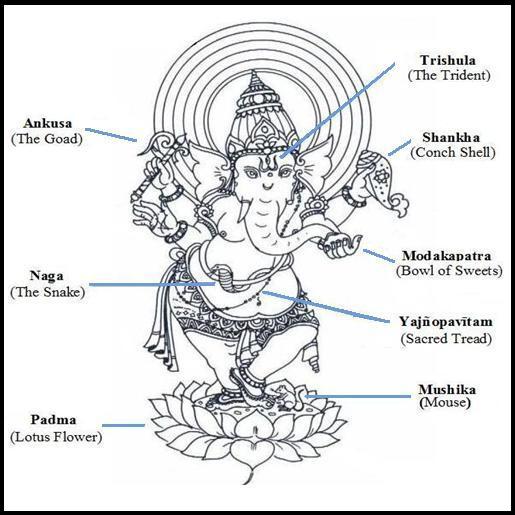
|
Aum/Om
(The sacred syllable)
|
“ Aum. The root mantra, soundless sound from which all creation issues forth.”
........The sacred syllable is written at the beginning and end of every sacred verse. It is associated with Ganesha, who rules over all
beginnings......
|

|
Ankusa
(The Goad)
|
Ganesha helps move us ahead on are karmic journey when we grow lazy or complacent. The Ankusa, held in Ganesha's right hand, is a hook-like instrument used by a mahout to train and guide an elephant.
|

|
Bhagnadanta
(Broken Tusk)
|
Ganesha is sometimes seen holding his own broken tusk, which he uses as a pen to write scriptures as the sage Vyasa dictates them. He teaches us that sacrifice is necessary in the pursuit of learning and higher spirituality.
|

|
Chamara
(Fly-whisk or Fan)
|
The Chamara can be used to whisk away thought of the past, worries and misleading thoughts as if they were insignificant flies.
“Lord Ganesha uses the Chamara to fan memories of the past from the minds of his followers and help them reside in the present.”
|

|
Gaja
(The Elephant)
|
The elephant, king of beasts and sign of royalty and power. Just as Ganesha stood guard over his mother’s chamber, statues of elephant, or living elephants, often stand guard at the entrance to Hindu temples.
|

|
Kamandalu
(The Water Vessel)
|
Ganesha’s kamandalu is always full, never needing to be refilled. It is a symbol of his endless capacity for love and his ability to provide his devotees everything they need.
|

|
Mala
(Prayer Beads)
|
A Mala is a strand of beads, similar to the Christian rosary. It is commonly made of rudraksha, tulasi or sandalwood. It is used to count prayers and aid mediation.
|

|
Modakapatra
(Bowl of Sweets)
|
Ganesha has a sweet tooth, not only for sweet foods, but the sweetest of all things – moksha (spiritual liberation) The modaka, Ganesha's favorite treat, is a round, lemon-sized sweet made of rice, coconut and sugar.
|

|
Murda
(Hand Gestures)
|
Hindu gods and saints are often shown with there hands in distinctive positions. Each gesture represents a different concept, such as generosity or inner-reflection. Ganesha’s up raised hand represents protection and welcome to his devotees.
|

|
Mushika
(Mouse)
|
Ganesha's is always shown with the image of a mouse, or Mushika, at his feet. This is Ganesha’s mount. It may seem comical for a large elephant to be riding on the back of a mouse, but this image is full of symbolic meaning.
“The mouse is a symbol of greed. Mice have the tendency to eat whatever it sees, and what they do not eat, they make usable. Lord Ganesha controls this aspect in one’s character.”
“Seated on Mushika, Ganesh crushes useless thoughts, which multiply like rats in the dark.”
“A mouse represents the timidity and nervousness that overwhelm us at the onset of any new venture”
|

|
Naga
(The Snake)
|
A snake, or Naga, is often shown on Ganesha’s arm or around his waist. It is indicative of Kundalini energy rising. The Naga snake is also one of the sacred *symbols of Ganesha’s father, Lord Shiva.
|

|
Padma
(Lotus Flower)
|
The lotus flower is a *symbol of beauty and purity. Rooted in the mud of a riverbank, its blossom rises above the muddy waters. It reminds us that by living our lives without attachments, we can gain release from the cycle karma.
"One who performs his duty without attachment, surrendering the results unto the Supreme Lord, is unaffected by sinful action, as the lotus leaf is untouched by water."
-- Bhagavad Gita 5.10
|

|
Pasha
(A Tether or Noose)
|
A three-strand tether or noose represents the soul's three-fold bondage of anava, karma and maya. God uses the spiritual Pasha to lead wandering souls, pashu, (lit. cows) along the path to truth. The Pasa may also refer to the tether used to restrain the wild elephant. Signifying that Ganesha may help us restrain our passions and desires.
|

|
Shankha
(Conch Shell)
|
The call of the conch shell is reminiscent of the trumpeting of the elephant. Ganesha uses it to call his followers to him. He summons, "Come to Me and pray." The conch is often blown to announce the beginning of a ritual a celebration and at dawn, the coming of the day.
|

|
Svastika
(Sign of Good Luck)
|
The Swastika was originally a sacred Hindu *symbol. Sadly, Hitler took this powerful *symbol and made it a *symbol of Nazism. Svastika (from the Sanskrit “It is well” ) is a *symbol of auspiciousness and good fortune. Ganapati is considered a God of success and good fortune.
|

|
Yajñopavītam
(Sacred Tread)
|
.......A thread made of three stands. It denotes that the “one who wear the sacred thread should be pure in his thought, word and deed.” ......
|
















